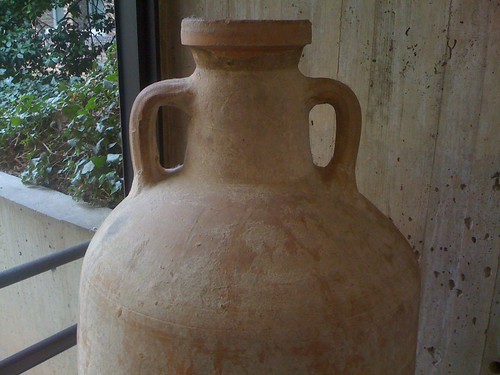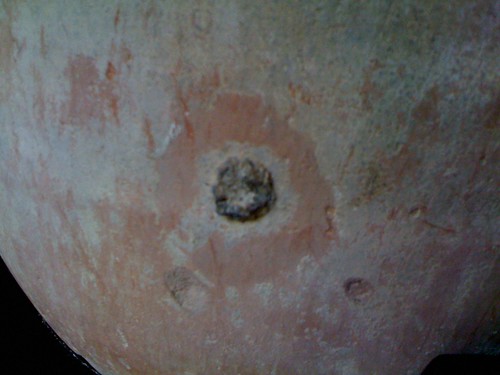Here are some pictures taken with my iPhone and presented unprocessed except for resizing. You can see that the results are OK for images taken from a distance but blurry for close-ups.

Overview

Close-up of Neck

Side view of handle

Partial view of "button toe"

Close-up of the surface

Close-up of plugged hole
The last image of the plugged hole is an opening for further comment. Ted Peña, in his book Roman Pottery in the Archaeological Record [worldcat], follows Bonifay (above, p. 467-8) in listing four methods of holing amphoras that contained liquid commodities. The first consists of:
the creation of one or two small holes ca. 1-2 cm. in diameter, usually by means of a drill, though sometimes by means of punching or chipping, generally in the lower third of the vessel's wall. This method is attested almost exclusively with examples of the Neo-Punic amphora, the "a gradino" variety of the African 2A, and the Keay 25. (p. 67)
The UPenn piece shows such holing in a Keay 62. Of course, we don't know that the vessel was pierced in antiquity and we don't know why the hole was re-filled, or when. It looks like the fill is lead, which certainly could be ancient. It seems likely that something was attached at the point of the hole, perhaps just excess lead. Perhaps not since the marks in the accretion show an incomplete ring as well as distance from the hole. I'm not sure what this means so comments are welcome. And what about the chips below the ring? There's a lot going on here when you take the time to look closely.
One reason to discuss holing of amphoras now is that tomorrow (6/20/2008) is the first day of the conference, "'Pottery in the archaeological record: a view from the Greek world'. A Workshop on J. Theodore Peña’s publication, Roman Pottery in the Archaeological Record", hosted by the Danish Institute at Athens. Consider this post a small contribution to the topic.
I'm grateful to Brian Rose for permission to discuss this piece, and to Lynn Makowsky for accession information.

No comments:
Post a Comment